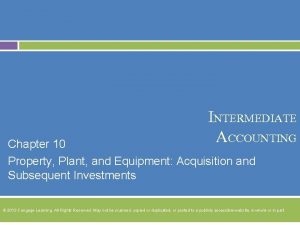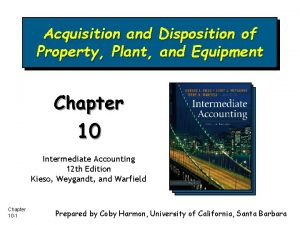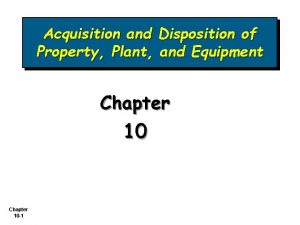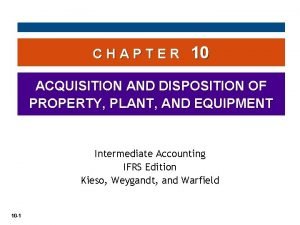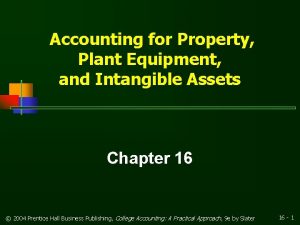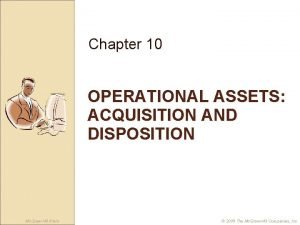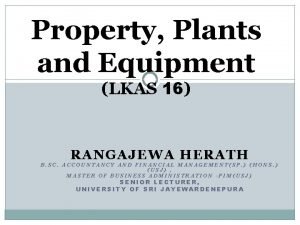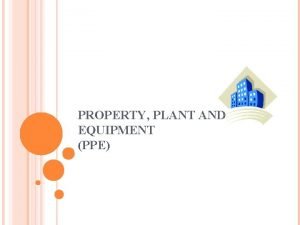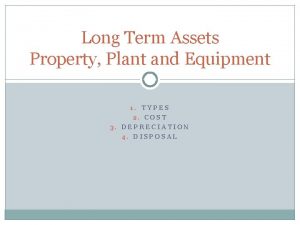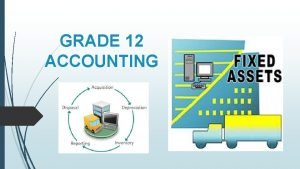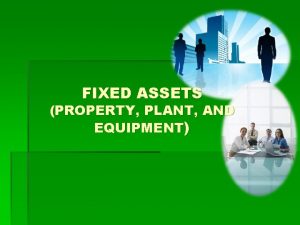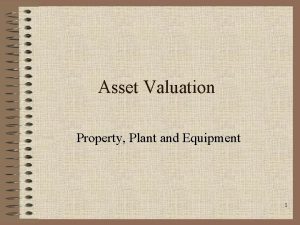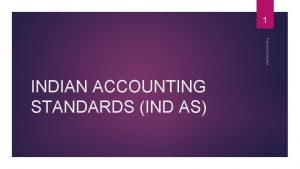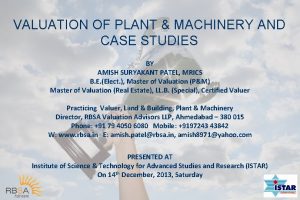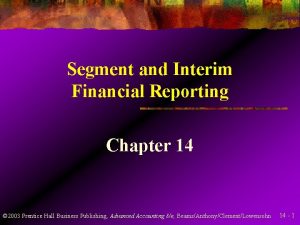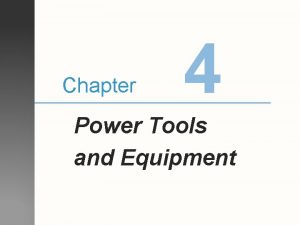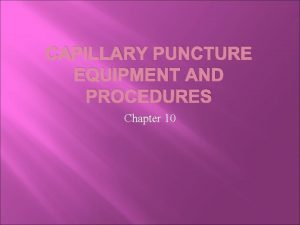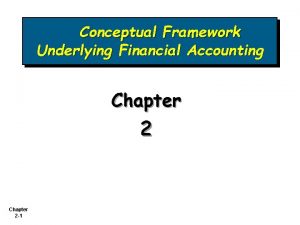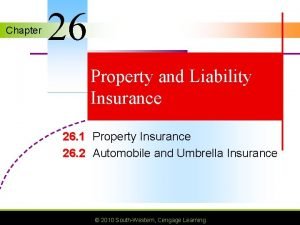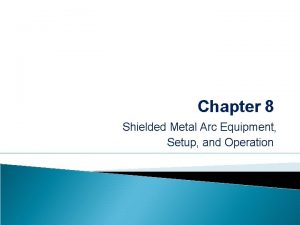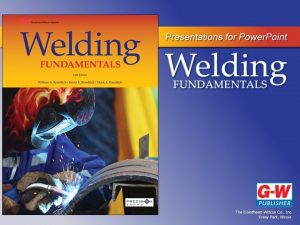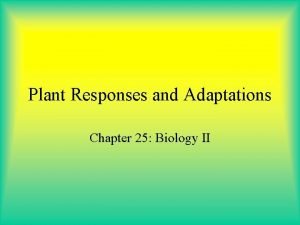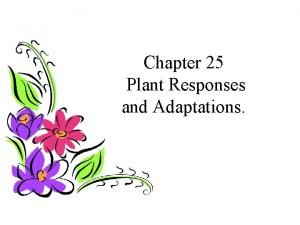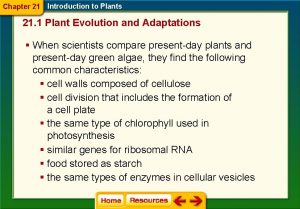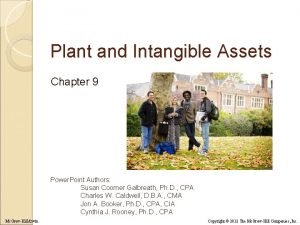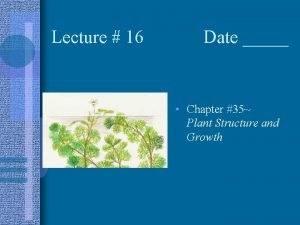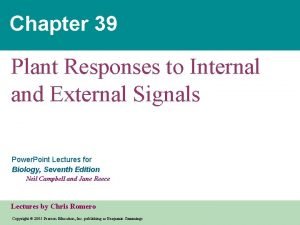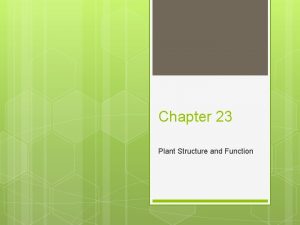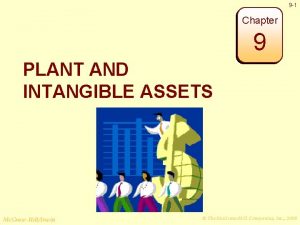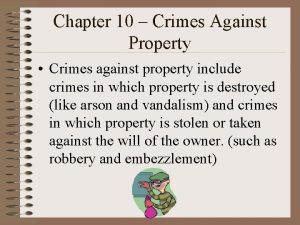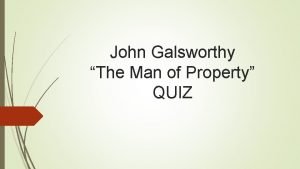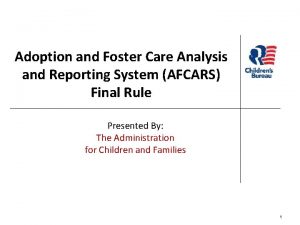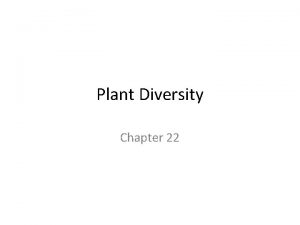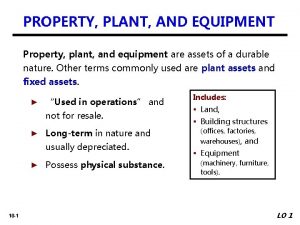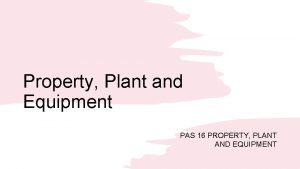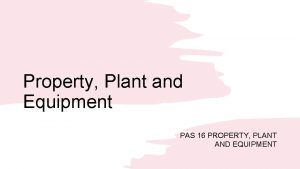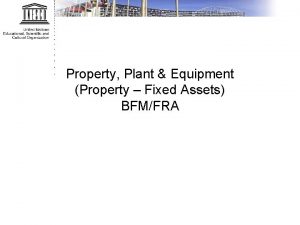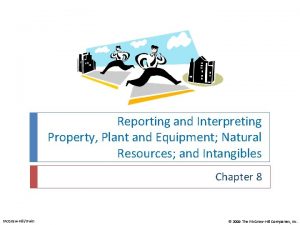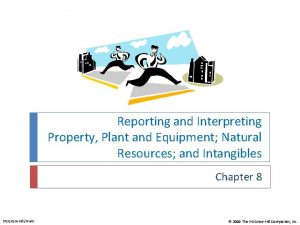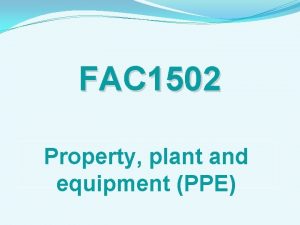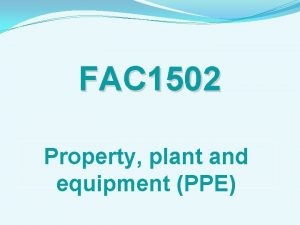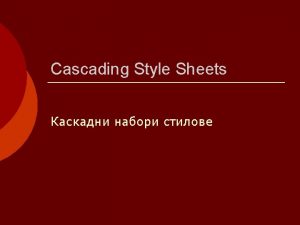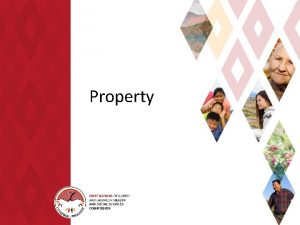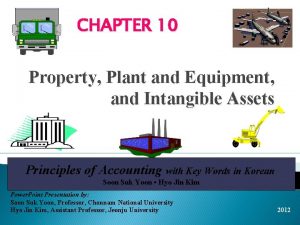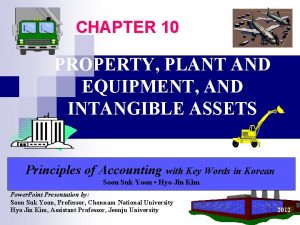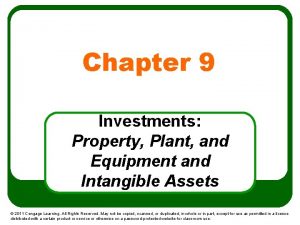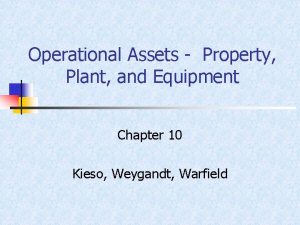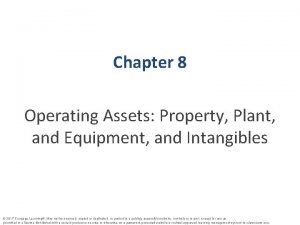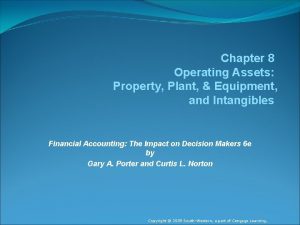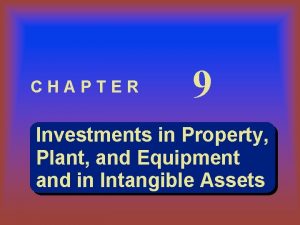CHAPTER 21 REPORTING PROPERTY PLANT AND EQUIPMENT AND

















































- Slides: 49

CHAPTER 21 REPORTING PROPERTY, PLANT, AND EQUIPMENT, AND INTANGIBLES 1

Chapter Overview q What type of assets does a company include in its property, plant, and equipment, and how does the company compute its historical costs? q Why does a company depreciate its property, plant, and equipment, and what are the causes of depreciation? q How does a company calculate its depreciation expense, and why does it compute depreciation expense differently for financial reporting than for income taxes? 2

Chapter Overview q How does a company evaluate the impairment of its property, plant, and equipment? q How does a company record and report the disposal of property, plant, and equipment? q How do external users evaluate information about a company’s property, plant, and equipment? q What are intangible assets and natural resource assets, and what does a company report about them? 3

Reporting Property, Plant, and Equipment q A company using GAAP is required to base its reporting of property, plant, and equipment (PPE) on two accounting concepts we discussed in earlier chapters: historical cost and matching. q Historical cost states that a company records its transactions on the basis of the dollars exchanged; in other words, the cost of the property, plant, and equipment purchased. q Historical cost provides the most reliable value and the most conservative value for PPE, reflecting GAAP’s emphasis on conservatism. 4

Reporting Property, Plant, and Equipment q The matching principle states that the cost of producing revenues for an accounting period must be deducted from the revenue earned. q Therefore, a company allocates the cost of using property, plant and equipment to revenues by recording depreciation expense, and reports PPE at its net book value on the balance sheet. q PPE is one of the most ideal illustration of how the GAAP matching principle is applied. 5

Computing the Cost of PPE q The cost of PPE includes all of the costs a company incurs to acquire the asset and get it ready for use. q Cost includes the purchase price (less purchase discounts), sales tax, applicable transportation costs, insurance, installation costs and similar costs. q A company determines the cost by reviewing the source documents (i. e. , invoices) used to record the purchase. 6

Underlying Reasons for Depreciating PPE q PPE provides a company with benefits for more than one year – these are long-lived productive assets. Thus, over the useful life, PPE contributes to producing revenues for the business. q PPE is depreciated for two reasons: (1) to reflect the systematic cost of producing revenues over the useful life of the PPE, and (2) to reflect physical wear and tear by use, passage of time, damage or other means. 7

Depreciation Issues Exhibit 21 -2 8

Service Life and Residual Value q Three factors are involved in the calculation of the depreciation amount: 1. The cost of the asset, 2. Estimated useful life over which a company expects the asset to be useful, and 3. Estimated residual value, the cash the company estimates it will receive from the sale or disposal of the asset at the end of its useful life. 9

Nature of Depreciation q A company does not record depreciation in an attempt to estimate the value of the asset. q Depreciation is an estimation process, a systematic means to ensure that the cost of producing revenues is not determined in an arbitrary manner. q The method of depreciation represents a rational means to relate the benefit of the asset in any given accounting period. 10

Nature of Depreciation q Two different depreciation methods are used as a systematic means of calculating depreciation. q The straight-line method is used when it is likely that the asset will produce equal benefits over its service life. q An accelerated method is used when it is likely that the asset will produce higher benefits in the early part of its service life and lesser benefits in succeeding periods. 11

Straight-Line Method of Depreciation q A company uses the straight-line method by allocating the cost of the asset, less its estimated residual value, equally to each period of the asset’s estimated service life. q The formula can be expressed as follows: Depreciation per Year (Cost – Estimated Residual Value) = Estimated Service Life 12

Recording Straight-Line Depreciation q If Unlimited Decadence buys a blending machine for $25, 000 on 1/1/04 and estimates its residual value is $2, 500 and its service life to be 5 years, what is the straight-line depreciation expense and how is it recorded? Depreciation for the year = $25, 000 - $2, 500/5, or $4, 500 per year Assets -$4, 500 (+Accumulated Depreciation: Blending Machine) = Liabilities + Stockholders’ Equity Remember that accumulated depreciation is a “contra-asset – as it increases, assets decrease -$4, 500 (+Depreciation Expense: Blending Machine) 13

Straight-Line Depreciation: Unlimited Decadence Blending Machine Exhibit 21 -3 14

Accelerated Depreciation Methods q GAAP allows company managers to choose among several accelerated methods of depreciation: (1) double-declining balance method, or (2) sum-of-the-years digits method. q Under an accelerated method of depreciation, depreciation expense is not recorded equally over the service life. q Instead, depreciation expense is higher in the first half of the asset’s service life and lower in subsequent years. 15

Double Declining Balance Method of Depreciation q A company uses the double declining balance (DDB) method by computing depreciation expense each year on the declining book value of the asset. q DDB means “double the straight-line” rate. In addition, residual value is ignored in computing depreciation but depreciation cannot be recorded below it. 200% Depreciatio n per Year = Estimated Service Life X Book Value at the Beginning of Year 16

Recording DDB Depreciation q If Unlimited Decadence buys a blending machine for $25, 000 on 1/1/04 and estimates its residual value is $2, 500 and its service life to be 5 years, what is the DDB depreciation expense and how is it recorded? Depreciation for the year = $25, 000 X 40%, or $10, 000 in year 1 Assets -$10, 000 (+Accumulated Depreciation: Blending Machine) = Liabilities + Stockholders’ Equity Remember that accumulated depreciation is a “contra-asset – as it increases, assets decrease -$10, 000 (+Depreciation Expense: Blending Machine) 17

Recording DDB Depreciation q Each year, 40% of the declining balance book value of the blending machine would be recorded as depreciation until the residual value is reached. Notice that in the last year, depreciation expense is limited to the amount which will bring the accumulated depreciation to $22, 500, leaving a book (residual) value of $2, 500. 18

Depreciation and Income Taxes q The depreciation rules for GAAP financial reporting and for Federal income tax reporting are not the same. q The objectives are different. Under GAAP, the objective is to prepare income statements that fairly present the income-producing activities of a company which are useful for decision makers. q The income tax rules are based on the Internal Revenue Code. Taxes are the primary source of governmental revenues and the tax rules provide incentives for business investment. 19

Depreciation and Income Taxes q Managers of a corporation have the responsibility to the stockholders to minimize income taxes without violating the law. q A corporation takes advantage of accelerated methods allowed under the tax rules, a system called the Modified Accelerated Cost Recovery System (MACRS). q As an example, General Motors, Exxon. Mobil, and General Electric have together saved around $17 billion in taxes by using MACRS. 20

Percentage of an Asset’s Cost Used to Compute MACRS Depreciation 21

Subsequent Expenditures q After purchasing an asset, a company often makes additional expenditures on the asset during its economic life. q A capital expenditure is a cost that increases benefits from the asset by increasing its usefulness or extending its service life, such as adding a new wing to a building. Capital expenditures are added to the cost of the asset and depreciated. q An operating expenditure is a cost that maintains the benefits originally expected from the asset, such as routine repair and maintenance costs. Operating expenditures are expenses in the year incurred. 22

Impairment of PPE q An asset is an economic resource that will provide future benefits to the company, such as the net operating cash flows that the company will receive from using the asset. q If the historical book value of an asset is less than its expected future net operating cash flows, longlived assets like PPE are said to be “impaired. ” q If the book value of an asset is not recoverable through its future net operating cash flows, a company must reduce the book value of the asset and record an impairment loss on its income statement. 23

Impairment of PPE q Impairment is a complex concept because it involves a two-step process. First, an impairment must exist. Second, an impairment loss must be calculated. q The amount of the impairment loss is the difference between the fair market value and book value of the asset. q If Unlimited Decadence determines there is an impairment loss on building and machinery with a fair market value of $2. 0 million and book value of $2. 5 million, a $500, 000 impairment loss is recognized. The book value of the asset is reduced to $2. 0 million. 24

Disposing of PPE q When a company disposes of a depreciable asset, one of three things happens: (1) the asset is sold for book value as of the date of disposal, (2) the asset is sold for more or less than book value as of the date of disposal, or (3) the asset is traded for another asset. q Regardless of the reason, a company records and reports depreciation expense for the current period up to the date of disposal. q Then it removes the special asset account and its related accumulated depreciation account from the accounting records. 25

Recording An Asset Disposal q If Unlimited Decadence sells office equipment for $1, 500 that originally cost $10, 000 and had a current book value of $1, 000 (accumulated depreciation of $9, 000), how would this be recorded? Since $1, 500 was received for an asset with a book value of only $1, 000, a gain of $500 is recognized on the disposal. Assets +$1, 500 (Cash) -$10, 000 (Office Equipment) Stockholders’ Equity +$9, 000 (-Accumulated Depreciation: Office Equipment) +$500 (Gain on Sale of Equipment) 26

Disclosure of Property, Plant and Equipment: Pepsico 27

Using PPE Financial Information 28

Intangible Assets q Intangible assets are a company’s long-term assets that do not have physical substance (as compared to property, plant and equipment). q These assets have value because they provide specific legal rights or economic benefits. Examples include patents, trademarks, tradenames, copyrights, franchises, and computer software. q For example, if Unlimited Decadence was a real corporation, it would own the exclusive right for the words “Unlimited Decadence”, “Empty Decadence”, and “Pure Decadence. ” 29

What Makes Intangible Assets Unique? q Intangible assets do not have physical substance like tangible assets (I. e. , property, plant, and equipment). q There is generally a higher degree of uncertainty regarding their future benefits; value is subject to wide fluctuations because it may depend on competitive conditions. q Intangible assets may have value only to a particular company. q They may have expected lives that are very difficult to determine. 30

Recording Intangible Assets q As with property, plant, and equipment, a company initially records an intangible asset at its acquisition cost. q For some intangibles, the company then allocates this cost as an expense over the asset’s useful life using the matching principle. This expense is called amortization expense and is the intangible equivalent of depreciation expense for tangible assets. q For other intangibles, no amortization expense is recognized. Instead, the company either expenses the cost currently or reviews the asset for impairment. 31

Expensing the Cost of Intangibles Exhibit 21 -14 32

Research and Development (R&D) Costs q Many companies engage in R&D to improve their products or services. q Research is aimed at the discovery of new knowledge for use in new or improved product development; development is the translation of research into a plan or design for new or improved product development. q Since R&D inherently has a high degree of uncertainty that any new or improved product will be generated, companies are required to expense these costs in the period incurred. 33

Patents q A patent is an exclusive right granted by the U. S. Government (or the government of another country) giving the owner of an invention the control of its manufacture or sale for 20 years from the date of the patent application. q The useful life may not be extended by modifications or improvements of the original invention. q As a general rule, a company records the cost of obtaining a patent, which are the external costs such as the patent application and any legal costs incurred, as an intangible asset. If purchased, the patent is recorded at its cost. 34

Copyrights q A copyright is an exclusive right granted by the U. S. government (or the government of another country) to publish or sell literary or artistic products for the life of the author plus an additional 70 years. q Copyrights cover such items as books, music, and films. q As a general rule, a company records the cost of obtaining a copyright, which are the external costs such as the copyright application and any legal costs incurred, as an intangible asset. If purchased, the copyright is recorded at its cost. 35

Trademark and Tradenames q A trademark or tradename is an exclusive right granted by the U. S. government (or the government of another country) to use a name or symbol for product identification. The right lasts for 20 years and is renewable indefinitely as long as it is being used. q Pepsi, Fritolay, Tropicana, Quaker and Gatorade are all examples of tradenames owned by Pepsico. q A company records the cost of obtaining a trademark/tradename, which are the external costs such as the application and any legal costs incurred, as an intangible asset. If purchased, the trademark/tradename is recorded at its cost. 36

Franchises q A franchise is an agreement entered into by two parties. For a fee, one party (the franchisor) gives the other party (the franchisee) rights to perform certain functions or sell certain products or services over the legal life of the franchise. q For example, many Mc. Donald’s restaurants are locally owned and operated under franchise agreements with Mc. Donalds Corporation. q As with other intangibles, a company records the cost of obtaining the franchise. 37

Computer Software Costs q A company that designs software for sale incurs three type of costs: software production costs, unit cost of producing the software, and maintenance and customer-support costs. q The first type of software production costs are R&D costs, which establish the technological feasibility of the product. Like other R&D costs, these are expensed as incurred. q Once technological feasibility has been established, the software production costs can be capitalized as an intangible asset. q After the product is ready for sale, subsequent software production costs are expensed. 38

Computer Software Costs q Computer software companies are a specialized industry with unique rules to determine the period over which software can be amortized once it is recorded as an intangible asset. q In practice, most companies expense the software production costs because technological feasibility does not occur until the software is produced. q For many companies, software may be the only revenue producing asset. One may argue that the accounting rules do not adequately provide the guidance that is needed. 39

Computer Software Costs q The second type of cost is the unit cost of producing the software, such as costs of the disks and the duplication of the software, packaging, documentation, etc. q These unit costs are treated as inventory and then as cost of goods sold when the software is sold to customers. q The third category is maintenance and customersupport costs after the software is released. These costs are recorded as expenses when incurred. 40

Goodwill q Goodwill is intrinsic value embedded in a business that causes a willing buyer to pay a price greater than the identifiable net assets it acquires. q Goodwill is the most intangible of intangibles and includes such items as a company’s reputation, trained employees, brand recognition, market share, high-quality products, innovative marketing, etc. – all of those intangible things that create earning power for a business. q It can only be recorded as an intangible if purchased. It is not subject to amortization but must be tested for impairment. 41

Amortization and Impairment of Intangible Assets q Intangible assets that have a limited life (i. e. , such as a patent, copyright) are amortized over the expected life of the benefits they produce. q Amortization expense, like depreciation expense, allocates a portion of the asset’s acquisition cost, to expense on a systematic basis. q Like PPE, intangible assets must also be reviewed for impairment. It may be necessary to record an impairment loss to adjust the value of the intangible on a company’s books if an impairment loss exists. 42

Recording Amortization q If a company has a patent that cost $20, 000 and has an estimated life of 10 years, how does the company record the yearly amortization? Assets -$2, 000 (+Accumulated Amortization: Patent) Amortization for the year = $20, 000/10 years = $2, 000 per year = Liabilities + Stockholders’ Equity Remember that accumulated amortization is a “contra-asset” like its accumulated depreciation counterpart – as it increases, assets decrease -$2, 000 (+Amortization Expense: Patent) 43

Disclosure of Intangibles: Pepsico Exhibit 21 -15 44

Natural Resource Assets q In addition to property, plant and equipment and intangible assets, some companies have natural resource assets (sometimes called wasting assets). q A natural resource asset is an asset that is used up as it is extracted, mined, dug up, or chopped down. Examples of natural resources assets include oil, coal, gravel, and timber. q A company accounts for these in the same manner as other categories of physical, longterm assets. 45

Natural Resource Assets q The cost of natural resources assets are also allocated to expense over the expected service life of the asset. q The expense is called “depletion” expense which is similar in nature to depreciation and amortization expense – different labels for different categories of assets. q A company uses the units-of-production method to compute depletion expense based on the amount of a natural resource asset that is used up. 46

Units-of-Production Method of Depreciation q A company uses the units-of-production method to record annual depletion on natural resources assets. q A depletion rate is computed based on the total expected units to be extracted from the natural resource. This rate is then applied to the actual units extracted during a period. Depletion Rate (Cost – Estimated Residual Value) = Total Estimated Lifetime Activity Level 47

Units-of-Production Method of Depreciation q If the Deep Pit Mine Company purchased a copper mine for $10 million (no residual value) and estimates that the mine will produce 10, 000 tons of copper, how is the depletion rate calculated? Depletion Rate (Cost – Estimated Residual Value) = Total Estimated Lifetime Activity Level $10, 000 tons of copper = $1, 000 per ton of copper 48

Units-of-Production Method of Depreciation q If the depletion rate is $1, 000 per ton of copper, how is the depletion calculated if 500 tons of copper are mined in 2004 from the Deep Pit Mine? 500 tons of copper X $1, 000 per ton = $500, 000 The depletion expense for 2004 = $500, 000. 49
 Chapter 10 property plant and equipment
Chapter 10 property plant and equipment Acquisition and disposition of property plant and equipment
Acquisition and disposition of property plant and equipment Commercial substance
Commercial substance Acquisition and disposition of property plant and equipment
Acquisition and disposition of property plant and equipment Property, plant, and equipment and intangible assets are
Property, plant, and equipment and intangible assets are Acquisition and disposition of property plant and equipment
Acquisition and disposition of property plant and equipment Ppe standard sri lanka
Ppe standard sri lanka Ppe
Ppe Net book value
Net book value Property plant and equipment note
Property plant and equipment note Useful life of property plant and equipment
Useful life of property plant and equipment Valuation of property plant and equipment
Valuation of property plant and equipment Ind as 16 property plant and equipment
Ind as 16 property plant and equipment Www.showmemoney.com
Www.showmemoney.com Obstructed heritage and unobstructed heritage
Obstructed heritage and unobstructed heritage Physical properties and chemical properties
Physical properties and chemical properties Plant and machinery valuation
Plant and machinery valuation Associative vs commutative
Associative vs commutative Tronsmo plant pathology and plant diseases download
Tronsmo plant pathology and plant diseases download Tronsmo plant pathology and plant diseases download
Tronsmo plant pathology and plant diseases download Albugo eye
Albugo eye Plant introduction in plant breeding
Plant introduction in plant breeding Plant breeding for disease resistance
Plant breeding for disease resistance Plant introduction in plant breeding
Plant introduction in plant breeding Segment and interim reporting chapter 8
Segment and interim reporting chapter 8 Chapter 4 power tools and equipment
Chapter 4 power tools and equipment Dermal puncture equipment
Dermal puncture equipment In alternators the welding current is produced on the
In alternators the welding current is produced on the Second level of conceptual framework
Second level of conceptual framework Chapter 2 conceptual framework for financial reporting
Chapter 2 conceptual framework for financial reporting Chapter 2 conceptual framework for financial reporting
Chapter 2 conceptual framework for financial reporting Chapter 26 property and liability insurance
Chapter 26 property and liability insurance Smaw equipment set up
Smaw equipment set up Fcaw vs gmaw
Fcaw vs gmaw Chapter 25 plant responses and adaptations
Chapter 25 plant responses and adaptations Chapter 25 plant responses and adaptations
Chapter 25 plant responses and adaptations Chapter 21 section 1 plant evolution and adaptations
Chapter 21 section 1 plant evolution and adaptations Chapter 22 plant structure and function answer key
Chapter 22 plant structure and function answer key Chapter 21 section 1 plant evolution and adaptations
Chapter 21 section 1 plant evolution and adaptations Chapter 9 plant and intangible assets
Chapter 9 plant and intangible assets Chapter 21 plant structure and function
Chapter 21 plant structure and function Chapter 35 plant structure growth and development
Chapter 35 plant structure growth and development Seed germination
Seed germination Primary growth and secondary growth in plants
Primary growth and secondary growth in plants Section 23-4 leaves
Section 23-4 leaves Plant and intangible assets chapter 9
Plant and intangible assets chapter 9 Crime against property
Crime against property Quiz on john galsworthy
Quiz on john galsworthy Foster care analysis reporting system
Foster care analysis reporting system Chapter 22 plant diversity
Chapter 22 plant diversity
